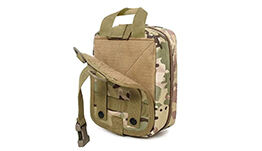What is IFAK?
In today's unpredictable world, it is essential to be prepared for any emergency situation that may arise. Whether you're an outdoor enthusiast, a first responder, or simply concerned about personal safety, having the right tools and knowledge can make all the difference. One tool that has gained significant recognition in recent years is the Individual First Aid Kit (IFAK). In this comprehensive guide, we will explore what an IFAK is, its contents, and why it is crucial to have one.
What is an IFAK?
An Individual First Aid Kit, commonly known as an IFAK, is a compact and portable medical kit designed to provide immediate medical assistance to an individual suffering from severe bleeding or other life-threatening injuries. The concept of IFAKs originated from military terminology during World War II, where soldiers were issued similar kits for emergency medical care.
The Importance of an IFAK
During high-stress situations, such as accidents, natural disasters, or even everyday emergencies, immediate medical attention can be the difference between life and death. Having an IFAK on hand allows individuals to provide self-aid or buddy-aid, enhancing their survivability and potentially saving lives. The IFAK is specifically designed to address two leading causes of death on the battlefield: severe hemorrhage and inadequate airway.
What goes into an IFAK?
The contents of an IFAK can vary depending on factors such as the level of training required, the location of the kit, and specific needs. However, there are several essential items that should be included in every IFAK:
1. Tourniquets
Tourniquets are considered the most critical life-saving equipment for treating severe bleeding in the event of penetrating trauma to an extremity. There are different types of tourniquets available, such as the Combat Application Tourniquet (CAT), SOFTT-W Tourniquet, and SWAT-T Tourniquet. It is essential to choose a tourniquet that suits your needs and become familiar with its application before an emergency arises.
2. Wound Packing Gauze
Effective wound packing involves using gauze to apply direct pressure to the wound cavity until bleeding stops. There are two types of wound packing gauze: conventional and hemostatic. Conventional gauze relies on physical pressure, while hemostatic gauze contains a hemostatic agent that accelerates clotting. Popular examples include QuikClot Combat Gauze.
3. Pressure Dressing and Bandages
Pressure dressings and bandages are used after wound packing to further restrict blood flow from a penetrating wound. Elastic bandages, such as the NAR Responder or NAR Control Wrap, are intuitive choices. Other options, like the Olaes Bandage or Israeli Bandage, incorporate wound-packing material and provide the ability to apply direct pressure and cover/protect the wound.
4. Shears
Shears are essential tools in emergency situations as they allow for the safe and quick removal of clothing to gain access to a wound. Talon Rescue Tactical Shears are a reliable choice for first responders.
5. Nitrile Gloves
When dealing with trauma, it is crucial to protect yourself and the patient from bloodborne pathogens. Nitrile gloves provide an effective barrier and should be included in every IFAK.
6. Rescue Blanket
Maintaining body temperature is crucial in preventing shock, especially for patients who have suffered severe trauma. Including a rescue blanket in your IFAK can help keep a casualty warm and improve their chances of survival.
7. Casualty Extraction Litter
In emergency situations, it is crucial to evacuate the injured quickly and safely. Lightweight and portable disposable litters, such as the Quiklitter, provide a means to transport patients with minimal risk.
Placing IFAKs Strategically
IFAKs should be conveniently accessible in various locations, including vehicles, homes, workshops, job sites, or places where the risk of severe lacerations or penetrating injuries is possible. Ensuring that IFAKs are readily available can significantly improve response time and potentially save lives.
Empowering with Equipment and Training
Having an IFAK is just the first step; proper training in its use and application is equally important. Although these medical tools are user-friendly, familiarity and prior training are imperative in high-stress situations. Muscle memory allows immediate responders to initiate actions quickly and effectively. Consider seeking out tactical medical and "stop the bleed" trainers in your area for comprehensive training.
In conclusion, an Individual First Aid Kit (IFAK) is an essential tool for individuals to provide immediate medical assistance in emergency situations. By including critical items such as tourniquets, wound packing gauze, pressure dressings, shears, nitrile gloves, rescue blankets, and casualty extraction litters, an IFAK equips individuals to respond effectively and potentially save lives. Remember, having an IFAK is only part of the equation; proper training and familiarity with the kit are vital to maximizing its potential. Stay prepared, stay safe.
Hot News
-
Advancements in Medical Structures: Enhancing Emergency Response and Patient Care
2025-06-13
-
The Vital Role of Stretchers in Emergency Medical Care
2025-03-07
-
DEVELOPMENT AND PROSPECT OF BATTLEFIELD INDIVIDUAL FIRST AID KIT
2025-02-20
-
Enhancing Emergency Response: The Role of IFAKs in Trauma Care
2025-02-20
-
Windlass Rod Tourniquet: An Essential Component in Emergency Medical Response
2025-02-13
-
The Windlass Rod Tourniquet: A Lifesaving Device in Emergency Medical Response
2025-02-13
-
Decompression Needle: Essential Design, Usage, and Future Directions in Trauma Care
2024-11-29
-
Top Medical Equipment Suppliers: Comprehensive Analysis
2024-01-15
-
What is IFAK?
2024-01-15
-
First Aid Kit Essentials and Tips
2024-01-15
 EN
EN
 FR
FR
 DE
DE
 IT
IT
 JA
JA
 KO
KO
 RU
RU
 ES
ES
 AR
AR
 BG
BG
 HR
HR
 DA
DA
 NL
NL
 FI
FI
 EL
EL
 NO
NO
 PL
PL
 PT
PT
 RO
RO
 SV
SV
 TL
TL
 ID
ID
 SR
SR
 UK
UK
 VI
VI
 SQ
SQ
 TH
TH
 TR
TR
 AF
AF
 MS
MS
 CY
CY
 IS
IS
 HY
HY
 AZ
AZ
 KA
KA
 MN
MN
 MY
MY
 KK
KK
 UZ
UZ
 CS
CS



